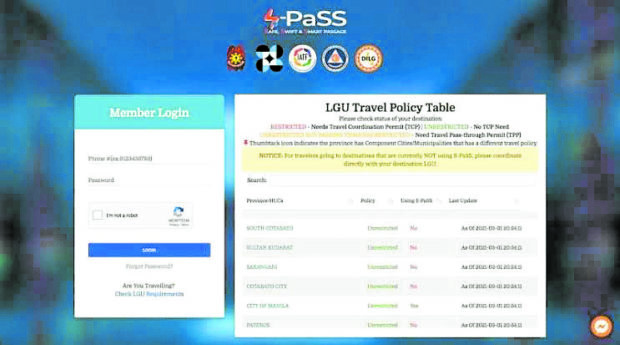S-Pass: Provincial bus passengers must register online before getting onboard

ONE-STOP PORTAL The S-Pass website is intended to keep local travelers updated on the various levels of quarantine restrictions across the country as it offers information on the status of provinces or cities and the kinds of permit they require.
Bus operators should require their passengers to register at the online portal, S-Pass system (https://www.s-pass.ph/), before buying their tickets, according to the Land Transportation Franchising and Regulatory Board (LTFRB).
Only passengers who can present proof of registration when buying a ticket will be allowed to board a bus, the agency said in a memorandum as part of its compliance with travel requirements during the COVID-19 pandemic.
The memorandum covers around 2,600 provincial buses entering Metro Manila and other reopened provincial routes. Penalties apply to violators, but the LTFRB did not specify them.
The agency said it adopted S-Pass in response to the request of the League of Provinces of the Philippines to develop a mechanism for monitoring the entry of travelers in the provinces.
This would also ensure the health and safety of those traveling between provinces and regions, it added.
Tied to StaySafe.ph
The Department of Science and Technology developed the S-Pass, short for Safe, Swift and Smart Passage, as a system to facilitate local travel in view of the varying levels of restrictions imposed by local governments in coping with the crisis.
The Inter-Agency Task Force for the Management of Emerging Infectious Diseases, the body overseeing the government’s response to the pandemic, had earlier required travelers to use S-Pass to complement the mandatory use of StaySafe.ph, the government’s primary contact tracing tool to mitigate the spread of COVID-19.
Travelers can log into the S-Pass one-stop portal to access information on travel restrictions in a province or city as well as submit travel requirements that will in turn be processed by their LGU (local government unit) of destination, according to the LTFRB. They can also check if their destination is using S-Pass.
‘Restricted’
If a province or a city is labeled as “restricted,’’ one is required to obtain a travel coordination permit or TCP. This replaced the travel authority that was previously required of returning overseas workers and locally stranded individuals.
One needs to secure a travel pass-through permit (TPP) if he is going to “unrestricted but passing through restricted” areas. Neither a TCP nor a TPP is required in an “unrestricted area.’’
A traveler’s province or city of destination has the prerogative to approve such permits.
In addition to the proof of registration with the S-Pass system, travelers are required to present TCP or TPP, if at all, before they are cleared to board the bus, according to the LTFRB.
So far, 88 provinces, highly urbanized cities and independent component cities are using the S-Pass system.
Of these, 31 provinces fall under the category of restricted and 30 unrestricted. Ten highly urbanized cities and independent component cities are labeled as restricted, while 17 are unrestricted.